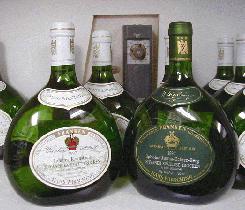
External search
Google (images)
Wine Advocate
Wine Spectator
Burghound
Wine-Searcher
Vintages
2018
2017
2015
2013
2012
2011
2010
2009
2008
2007
2006
2005
2001
1999
1985
From this producer
Show all wines
All tasting notes
|
| Drinking Windows and Values |
| Drinking window: Drink between 2011 and 2014 (based on 4 user opinions) |
| Community Tasting History |
| Community Tasting Notes (average 86.7 pts. and median of 88 pts. in 4 notes) - hiding notes with no text | | | Tasted by danstrings on 1/28/2012 & rated 88 points: Interesting white, very floral and almost Gewurtz-ish yet totally dry. Good liveliness on the tongue with floral/fruit notes. (3381 views) | | | Tasted by drwine2001 on 4/16/2011: Baby powder and citrus. Slightly pungent but no weird Scheurebe characteristics. Medium body, candied green apples, good palate coverage and excellent dry finish. Fascinating and really very good. Can't say I've had much experience with Franken Scheurebe! (3978 views) | | | Tasted by Badfish on 10/30/2010 & rated 90 points: Oktoberfest: 2009 Germans (Wine Exchange - Orange, CA): Steely and pungent in tone on the nose with notes of petrol, stone fruits, minerals, and sweet chalk. The palate yields unique flavors and a smooth mouthfeel combined with great acidity. The delicate high toned flavors consist of white and yellow fruits, minerals, spices, and herbs. This is a really unique and attractive dry Riesling. (4669 views) |
| Hans Wirsching Producer website Located in Iphofen.
U.S. Importer (Addt'l Info)ScheurebeWikipedia Scheurebe articles: German language, English languageKabinett trocken German wine classificationIphöfer Kronsberg On weinlagen.infoGermany Wines of Germany | The Association of German Prädikat Wine Estates (VDP) | How to read a German wine label | Geographical Information Down to Single Vineyards
#2014 Vintage Notes:
2014 Vintage Report by Terry Theise
2014 Vintage Report by Wine Spectator
"My gut still tells me the Saar (and to some extent) the Ruwer are better overall in 2014 than the more storied areas of the Mosel proper, but those that spent the requisite time living in their middle-Mosel vineyards made some of the most electric and "feathery" Riesling in a long time (maybe the finest in 20 years - yes, it's true!)" - Jon Rimmerman (Of course only a very short historical memory would call the Saar and Ruwer less 'storied' than the middle Mosel - jht)FrankenFranken or Franconia is furthest east of ther wine growing regions in western Germany, which makes its climate the least Atlantic and the most Continental.
The Main River and its tributaries provide vines with good irrigation, but unlike the Rhine, the Main does not provide a balanced climate. There are often quick changes in the weather which makes the life of the grapes in the vineyards - planted on the hilly slopes bordering the river - more difficult than in other regions .... but it results in a heartier wine. This may be due to the production of thicker grapeskins in part. The hotter summers and briefer autumns particularly are responsible for this.
While the vine was historically densely planted in this area, the planting is today more broken up by other land uses, and probably only the best sites have survived as vineyards.
However, this region (which is actually northern Bavaria) is dotted with well-preserved imperial 'free towns' from the Middle Ages, since the region was well-placed to exploit emerging trade and technology during this era. This makes a trip here a rich cultural, as well as a vinous, experience, and can be enthusiastically recommended. Towns worth seeing include Würzburg, Regensburg, Nuremburg, Schweinfurt, and many others. This is the capital of the rich southern German Baroque architecture, with many earlier survivals from the Gothic and Romanesque periods as well.
Wines from the Franken region are traditionally very dry white wines. The Stein vineyard, near Würzburg, gave rise to the generic term "Steinwein" by which these wines have generally been known. The distinctive round-shaped, flat green bottle, called a "Bocksbeutel," is also an instant visual clue to their origins. The Bocksbeutel is reserved by law to this region and a small part of Baden that was historically connected to Franconia. However, not all Frankenweine are sold in Bocksbeutels, which can be difficult to cellar because of their shape.
There are three main regions in Franconia: The Mainviereck to the West, a quadrangular region whose main soil is red sandstone and which can make some superb red Spätburgunder wines, the Maindreieck, a triangular region in the center that includes the Würzburg area and which is predominately limestone, excellent for white wines, and the Steigerwald region to the East, a scattered, forested area whose soil is rich in gypsum and alabaster and which have a salty, mineral-laden style of their own.
Müller-Thurgau and Silvaner grapes are the principal varieties grown to produce these hearty, earthy dry wines often compared to white wines from France's Burgundy region, but which have a distinctive style and quality that is all their own. Müller-Thurgau and Silvaner both can make here wines of higher quality than is found anywhere else. The Silvaner wine is certainly a noble variety grown here on the best sites. This makes dry white wines that Hugh Johnson compares in their way to white Burgundy, if not for flavors then for the place at the table. The Rieslaner grape can grow especially well in this region.
The Silvaner (elswhere often called Sylvaner) grape was first imported into Germany from Austria into the Steigerwalt region at Castell.
Bacchus and Ortega grapes are are also grown in the region, often resulting in late harvest wines which are sweeter than the traditional Franken wines. Overall, Franken wines are usually consumed locally and not exported in great quantities, so if you're planning a trip through Franken, drink up!
Interactive map on weinlagen.info |
|




